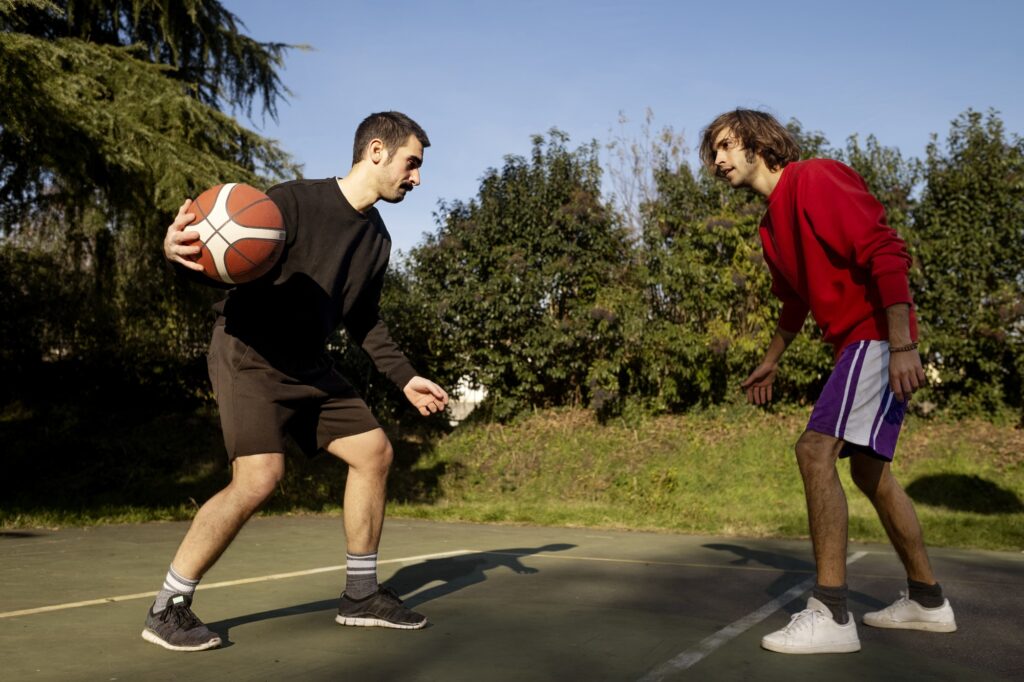How Playing Your Favorite Team Sport Contributes to Your Health-Related Fitness Goals
Participating in a team sport is not only about fun and competition—it’s also an effective way to achieve your health-related fitness goals. Whether you’re playing soccer, basketball, volleyball, or any other team sport, engaging in regular physical activity can significantly improve your overall health and fitness. In this article, we’ll explore how your favorite team sport can contribute to your health-related fitness goals, focusing on aspects like cardiovascular health, strength, flexibility, endurance, and mental well-being.
1. Cardiovascular Health: A Key Benefit of Team Sports
Team sports often require players to run, jump, and sprint, which places a significant demand on the cardiovascular system. Whether you’re chasing a soccer ball down the field or rushing to make a basketball shot, your heart rate increases as your body exerts energy. This continuous movement is excellent for improving cardiovascular health, helping to lower your risk of heart disease, high blood pressure, and stroke.

How Team Sports Improve Cardiovascular Fitness:
- Increased Heart Rate: Constant movement during gameplay increases your heart rate, which strengthens the heart muscle and improves circulation.
- Enhanced Oxygen Delivery: As you engage in vigorous activity, your body becomes more efficient at delivering oxygen to the muscles, improving aerobic capacity and stamina.
- Improved Endurance: The repetitive and sustained nature of team sports boosts endurance, enabling players to maintain higher levels of intensity for extended periods.
Playing a team sport regularly allows you to meet and even exceed the recommended cardiovascular exercise guidelines, which typically suggest 150 minutes of moderate aerobic activity per week.
2. Strength and Power Development
Team sports are fantastic for building both muscular strength and power. The dynamic movements involved—whether it’s running, jumping, pushing, or pulling—engage multiple muscle groups simultaneously. For example, when playing basketball, players use their legs for jumping and their upper body for shooting, dribbling, and passing. In soccer, players rely on their legs for kicking, sprinting, and changing direction quickly.
How Team Sports Promote Strength:
- Full-Body Engagement: Many team sports require the use of various muscle groups. For instance, soccer players utilize their legs, core, and upper body in both offensive and defensive plays. Basketball players rely on leg strength for jumping and quick movements, as well as upper body strength for shooting and rebounding.
- Functional Strength: The functional movements in team sports translate directly to real-life activities, improving your ability to lift, carry, push, and pull objects with ease.
- Increased Muscle Mass: Regular participation in team sports helps build muscle mass, especially if the sport involves explosive movements, such as sprinting or tackling.
Strength training through team sports also helps prevent injuries by improving joint stability and flexibility.
3. Improved Flexibility and Coordination
Flexibility and coordination are crucial components of health-related fitness. These aspects are especially emphasized in team sports, where players must be agile and quick in response to the ball or other players’ movements. Flexibility enhances the range of motion in your joints, while coordination ensures that you can move efficiently and respond quickly to dynamic game situations.
How Team Sports Boost Flexibility and Coordination:
- Agility Drills: Many team sports incorporate agility drills that involve sudden stops, starts, and changes in direction. This helps improve flexibility in the lower body, particularly in the hips, knees, and ankles.
- Core Stability: Sports like soccer and basketball require strong core stability to maintain balance and coordination while performing fast, unpredictable movements. A well-developed core can reduce the risk of falls and injuries.
- Balance and Body Awareness: Regular participation in team sports helps improve proprioception (your body’s awareness of its position in space), allowing for better balance and coordination in daily activities.
Flexibility exercises incorporated into a warm-up or cool-down routine are also beneficial for injury prevention, ensuring your muscles and joints are prepared for the physical demands of the game.
4. Endurance and Stamina Building
Endurance refers to your ability to sustain prolonged physical activity, and stamina is the energy needed to complete tasks without exhaustion. Team sports provide an excellent environment to build both endurance and stamina, as they often involve continuous movement and sustained effort over long periods.
How Team Sports Enhance Endurance:
- High-Intensity Interval Training (HIIT): Many team sports mimic the structure of HIIT, which involves bursts of intense activity followed by periods of rest or lower intensity. This type of training improves both aerobic and anaerobic endurance, enabling you to perform at a higher intensity for longer.
- Pacing: Team sports teach athletes how to manage their energy over the course of a game. Players learn when to conserve energy and when to push hard, helping to build both physical and mental endurance.
- Longer Game Duration: Most team sports last for a significant amount of time (e.g., 90 minutes in soccer, 48 minutes in basketball), allowing players to gradually build stamina over the course of a season.
As you improve your endurance, you’ll also experience the benefits of higher energy levels and improved performance in other physical activities.
5. Mental Well-Being and Stress Relief
Physical health is only one aspect of your fitness journey. Mental well-being plays a crucial role in achieving overall health, and team sports offer substantial psychological benefits. Participating in a team sport can reduce stress, improve mood, and even enhance cognitive function.
How Team Sports Improve Mental Health:
- Stress Reduction: Physical activity, including team sports, stimulates the production of endorphins—your brain’s “feel-good” chemicals. These endorphins can help combat stress and anxiety, leading to a more relaxed and positive outlook.
- Increased Self-Esteem: Success in team sports—whether through skill development or winning games—boosts self-esteem and confidence. The sense of accomplishment and mastery is a key component of mental fitness.
- Social Connections: Being part of a team creates a sense of community and belonging. Positive social interactions with teammates can alleviate feelings of loneliness and isolation, contributing to a better mental state.
- Improved Cognitive Function: The mental focus required in team sports enhances cognitive functions such as decision-making, reaction time, and strategic thinking, which are beneficial for mental clarity in other aspects of life.
6. Social Interaction and Teamwork
One of the unique aspects of team sports is the opportunity to work together as a unit. Effective teamwork is essential for achieving success, and this not only enhances performance on the field but also develops valuable social skills. Participating in a team sport promotes communication, trust, and mutual support, which can positively influence your personal and professional life.
How Team Sports Build Social Skills:
- Communication: Playing a team sport requires constant communication between teammates, whether it’s calling for the ball, directing plays, or offering encouragement. This helps you develop stronger interpersonal communication skills.
- Cooperation: Team sports foster an environment of cooperation, where each member plays a vital role in achieving a shared goal. Learning to cooperate with others builds empathy, trust, and collaboration skills.
- Conflict Resolution: Differences of opinion are natural in any team environment, and team sports teach individuals how to manage conflicts and work towards a resolution. These skills are transferable to various areas of life, including work and family dynamics.
7. Injury Prevention and Rehabilitation
While playing team sports can be physically demanding, they also provide the opportunity for injury prevention and rehabilitation. Sports like soccer, basketball, and football promote proper warm-up and cool-down routines that help reduce the risk of injury. Additionally, if injuries do occur, the structured nature of team sports often includes rehabilitation protocols to ensure players return to full fitness safely.
How Team Sports Aid Injury Prevention:
- Warm-Up and Cool-Down Routines: Stretching and warming up before a game helps prepare the muscles and joints for physical exertion. Cooling down post-game helps reduce muscle stiffness and prevent injury.
- Strong Muscles and Joints: Regular participation in team sports helps to strengthen muscles and joints, reducing the likelihood of common injuries like sprains and strains.
- Guided Rehabilitation: In some cases, team sports programs provide access to trainers or physical therapists who can guide injured players through rehabilitation exercises, ensuring a safe return to full fitness.
FAQs
1. How often should I play a team sport to see health benefits? To see significant health benefits, it’s recommended to engage in team sports at least 3-4 times a week for 30-60 minutes each session. Consistency is key to achieving and maintaining fitness goals.
2. Can team sports help with weight loss? Yes, team sports can be an effective way to burn calories and promote weight loss. The high-intensity movements, coupled with cardiovascular and strength benefits, create an ideal environment for fat burning and muscle toning.
3. Are team sports suitable for all ages and fitness levels? Team sports can be adapted for people of various ages and fitness levels. Whether you’re a beginner or an advanced athlete, there are recreational and competitive options available for everyone. Always start at a level that matches your current fitness and gradually increase the intensity.
4. What if I don’t have a team sport to play? If you don’t have a team to join, consider recreational leagues, local community centers, or school clubs. Many areas offer opportunities for amateur and casual play, allowing you to meet new people and stay active.
5. How do team sports impact mental health? Team sports can significantly boost mental health by reducing stress, improving mood, increasing self-esteem, and offering social connections that alleviate loneliness and promote well-being.
Conclusion
Playing a team sport is.
